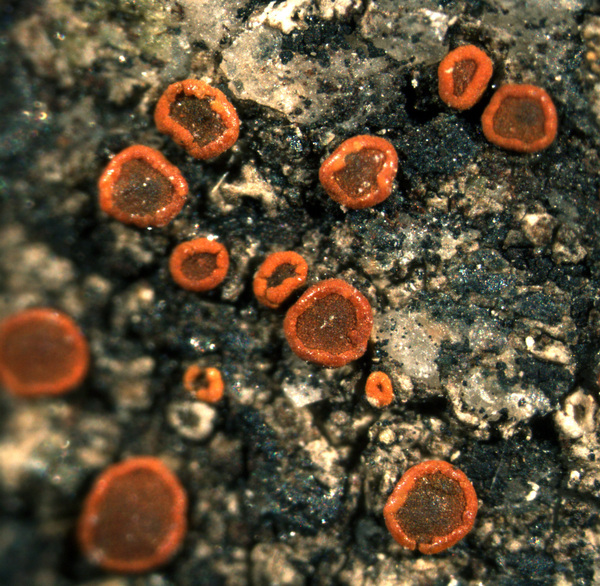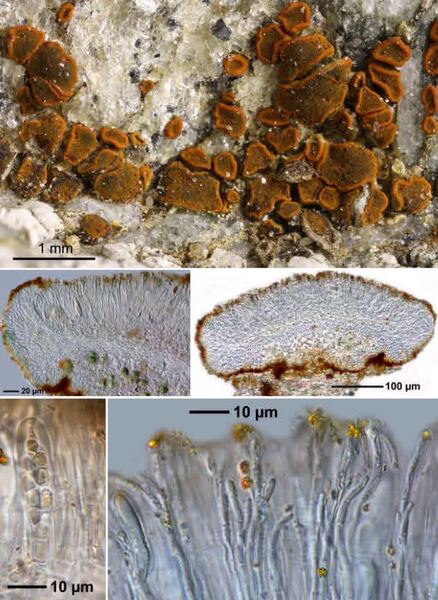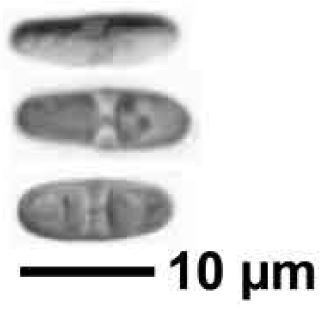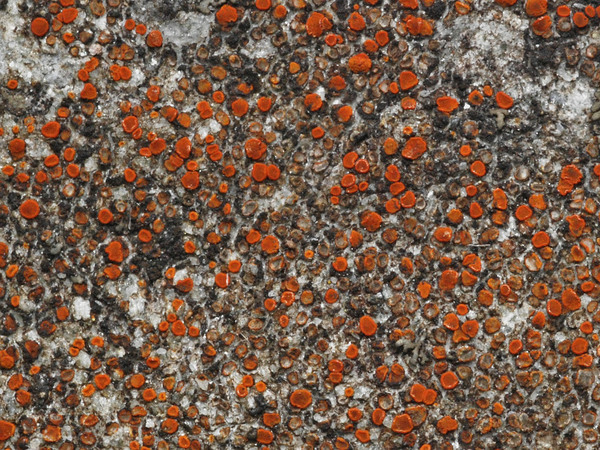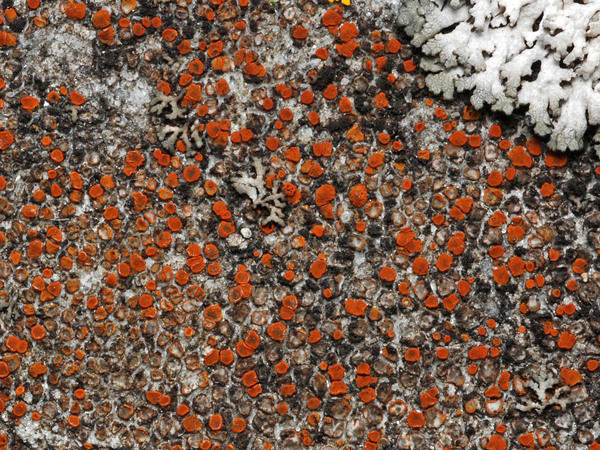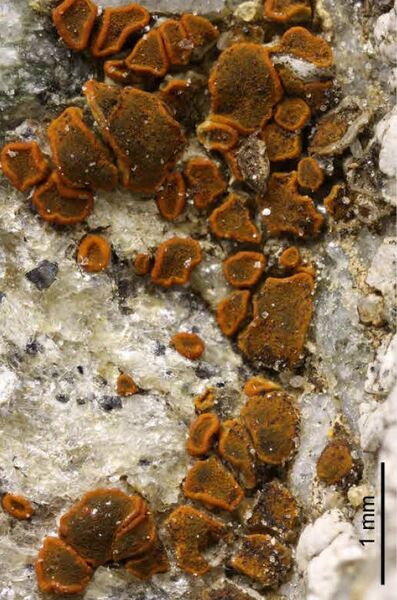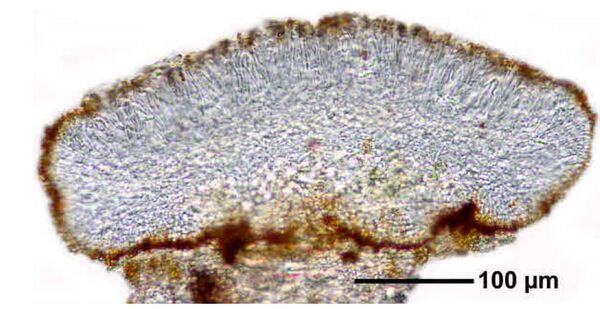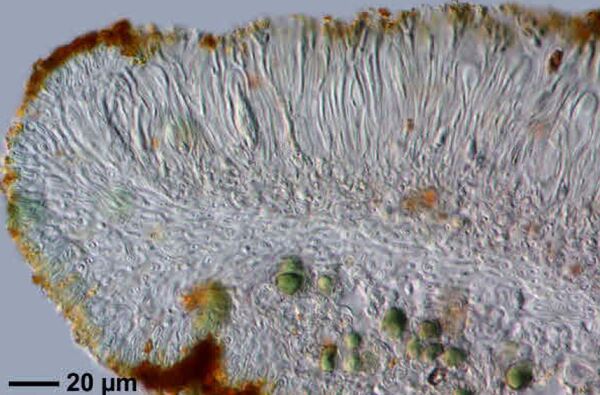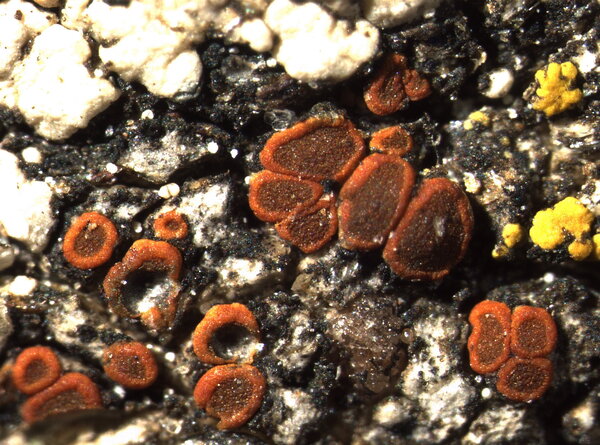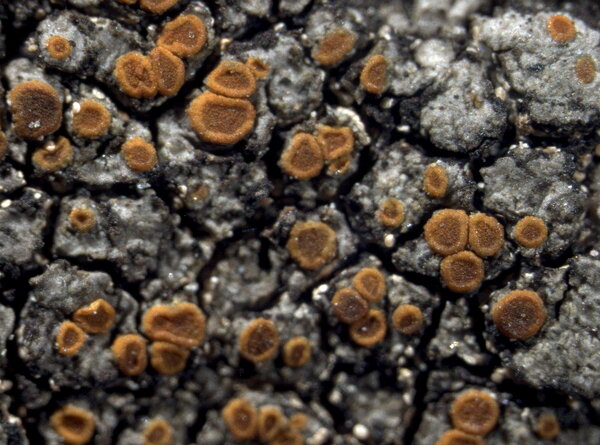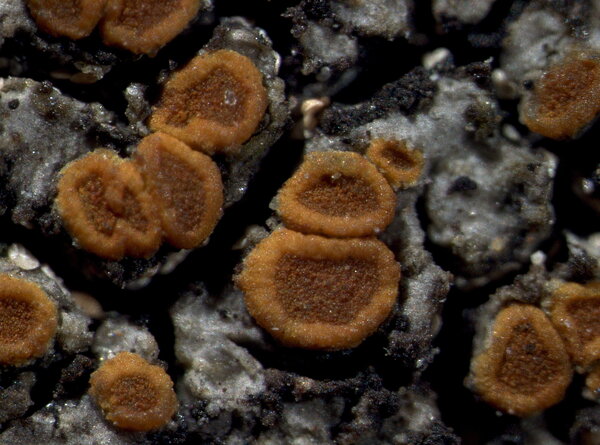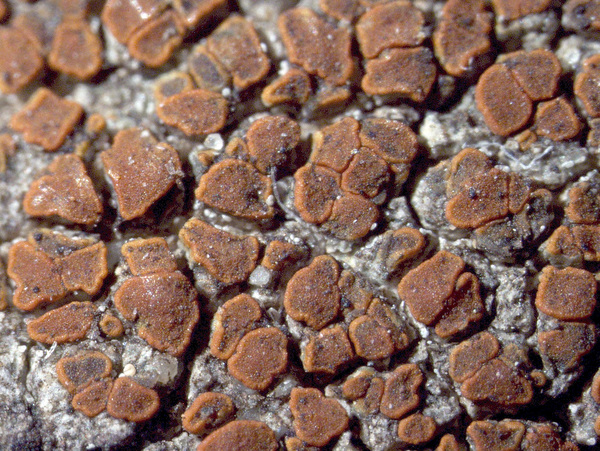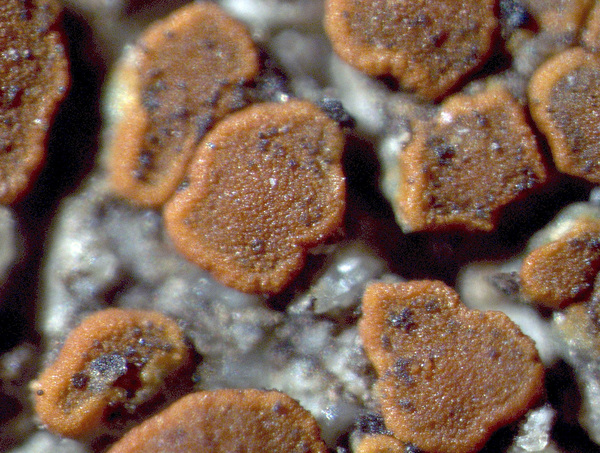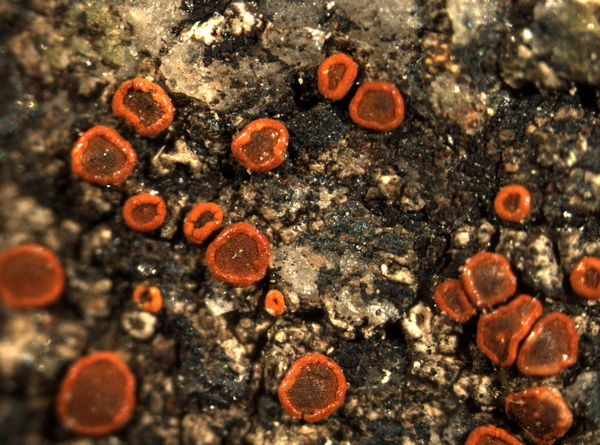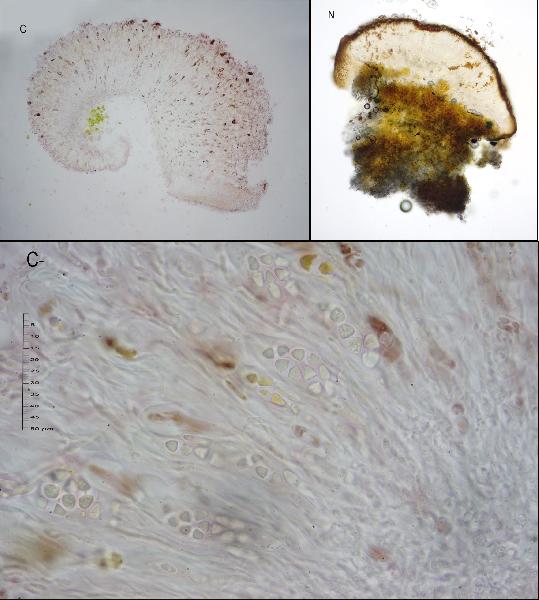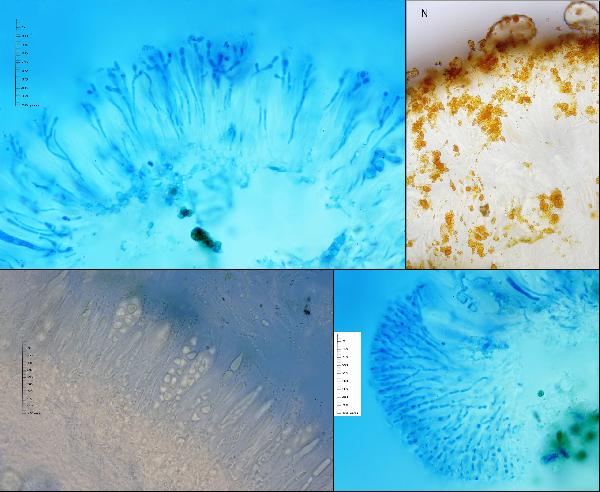Rufoplaca arenaria (Pers.) Arup, Søchting & Frödén
Nord. J. Bot., 31: 74, 2013. Basionym: Lichen arenarius Pers. - Ann. Bot. (Usteri), 1: 27, 1794.
Synonyms: Blastenia arenaria (Pers.) A. Massal.; Blastenia lamprocheila (DC.) Arnold; Caloplaca arenaria (Pers.) Müll. Arg.; Caloplaca craspedia (Ach.) Szatala; Caloplaca ferruginascens (Nyl.) H. Olivier; Caloplaca lamprocheila (DC.) Flagey; Lecanora lamprocheila (DC.) Nyl.
Description: Thallus crustose, indistinct or very thin, pale grey to grey-brown, often developing on other crustose lichens. Cortex with the Sedifolia-grey pigment (K+ faintly violet in sections); medulla poorly evident. Apothecia common, (0.3-)0.5-1(-1.5) mm across, with a bright rust-red, flat to finally slightly convex disc becoming darker and brownish orange with age and a slightly paler, raised proper margin. Epithecium brownish orange, granular, K+ purple-red; hymenium and hypothecium colourless; paraphyses gradually broadening to 3-4 μm at apex. Asci 8-spored, clavate, functionally unitunicate, apically thickened with a broad internal beak, the inner part of apex and external cap I+ blue, Teloschistes-type. Ascospores 2-celled, polarilocular, hyaline, narrowly ellipsoid, 10-18 x 4-6(-8) μm, the equatorial thickening (“septum”) (1.5-)2-3.5 μm, c. 1/5 of spore length. Spot tests: thallus K-, C-, KC-, P- (but section of cortex, when present, K+ faintly violet, N+ red); apothecial disc and proper margin K+ purple-red, C-. Chemistry: cortex with the Sedifolia-grey pigment; epithecium and proper margin of apothecia with unchlorinated anthraquinones.
Growth form: Crustose
Substrata: rocks
Photobiont: green algae other than Trentepohlia
Reproductive strategy: mainly sexual
Poorly known taxon in need of further study
Commonnes-rarity: (info)
Alpine belt: very rare
Subalpine belt: rare
Montane belt: rather rare
Dry submediterranean belt: rather common
Humid submediterranean belt: rather common
Padanian area: rare
pH of the substrata:
1 2 3 4 5
Solar irradiation:
1 2 3 4 5
Aridity:
1 2 3 4 5
Eutrophication:
1 2 3 4 5
Poleotolerance:
0 1 2 3
Altitudinal distribution:
1 2 3 4 5 6
Rarity
absent
extremely rare
very rare
rare
rather rare
rather common
common
very common
extremely common
Loading data...
Occurrence data
Predictive map
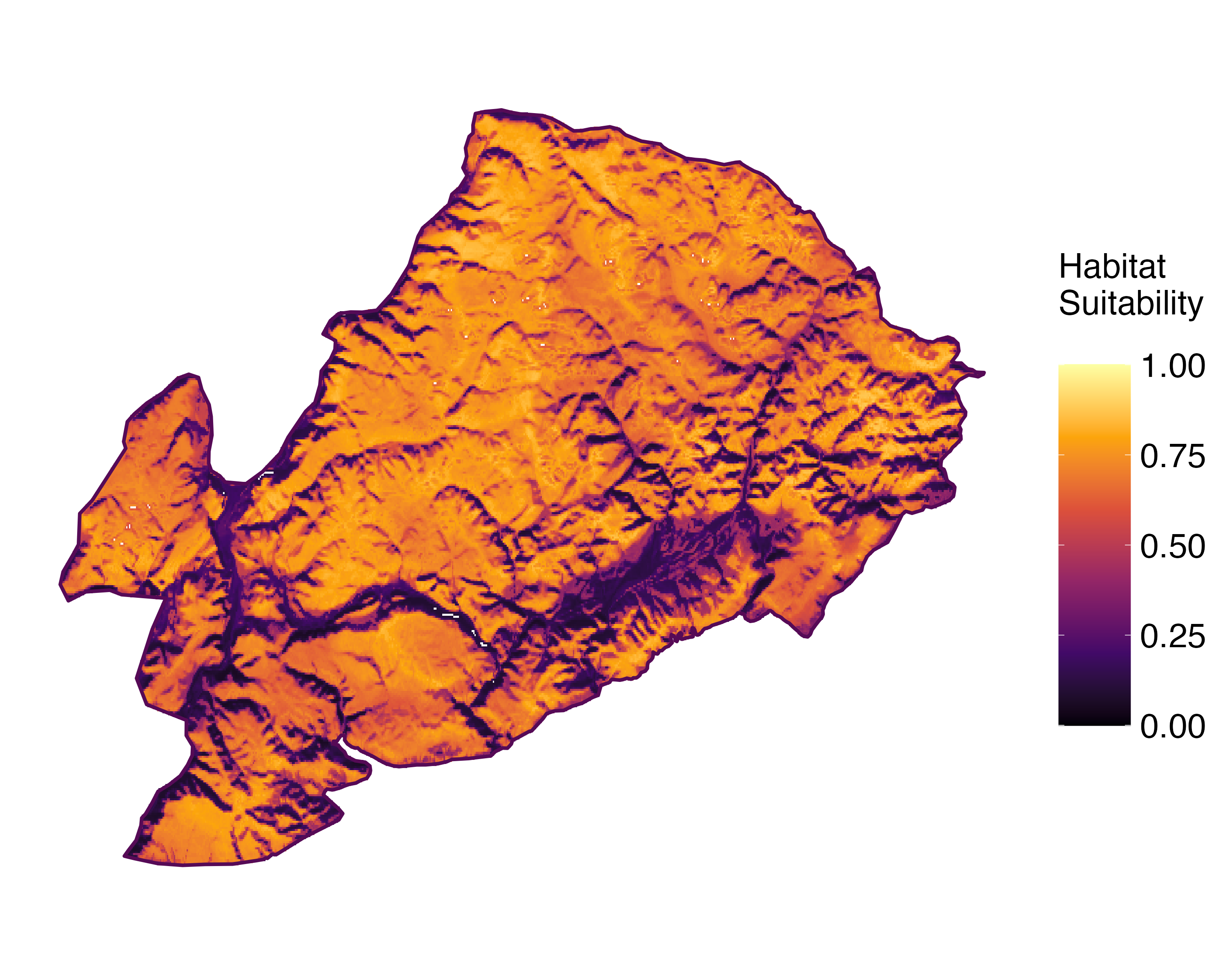 Current prediction (1981-2010)
Current prediction (1981-2010) Future prediction (2071-2100) SSP 1-2.6
Future prediction (2071-2100) SSP 1-2.6 Future prediction (2071-2100) SSP 5-8.5Predictive maps according to Francesconi et al. 2025
Future prediction (2071-2100) SSP 5-8.5Predictive maps according to Francesconi et al. 2025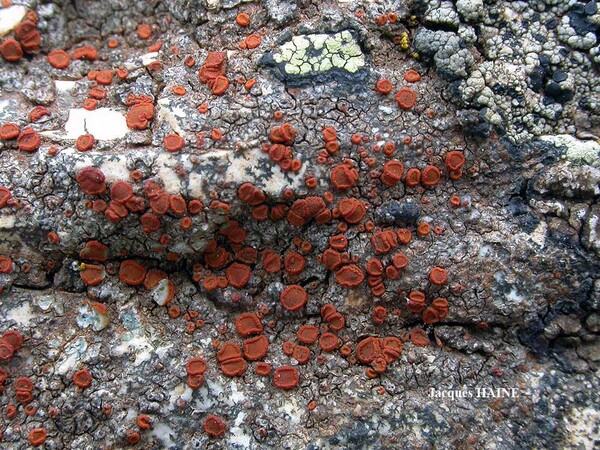
Jacques Haine - Source: http://www.lichensmaritimes.org/index.php?task=fiche&lichen=277&lang=en
France, Ventoux
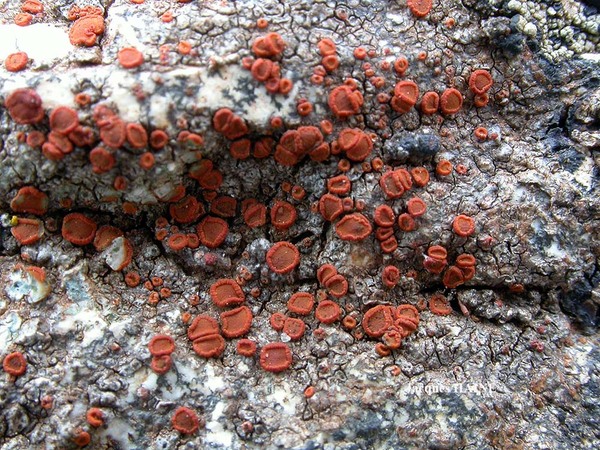
Jacques Haine - Source: http://www.lichensmaritimes.org/index.php?task=fiche&lichen=277&lang=en
France, Ventoux
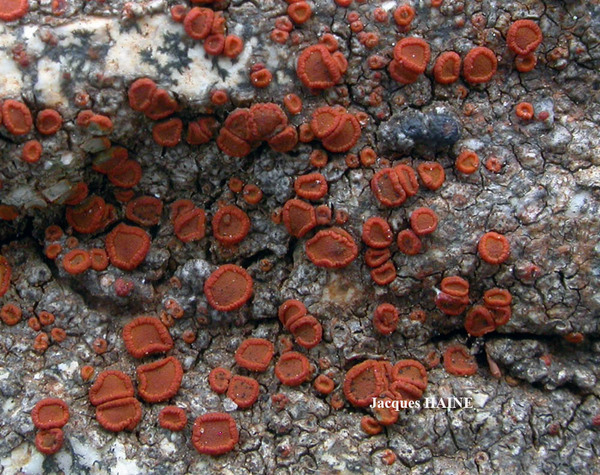
Jacques Haine - Source: http://www.lichensmaritimes.org/index.php?task=fiche&lichen=277&lang=en
France, Ventoux
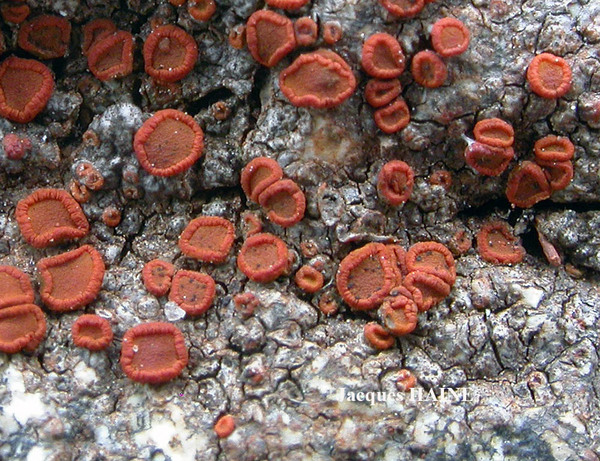
Jacques Haine - Source: http://www.lichensmaritimes.org/index.php?task=fiche&lichen=277&lang=en
France, Ventoux
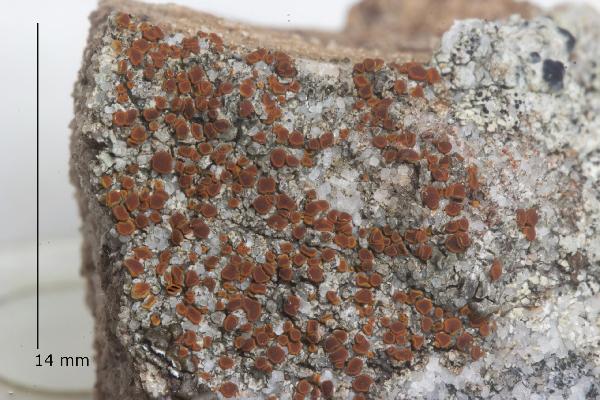
Marta González Garcia - Centro de Estudios Micologicos Asturianos
Spain, Valdorria (León), 11-VII-2024, sobre rocas ácidas junto a Candelariella coralliza y Pleopsidium chlorophanum a 1400 m de altitud, MGG-128.
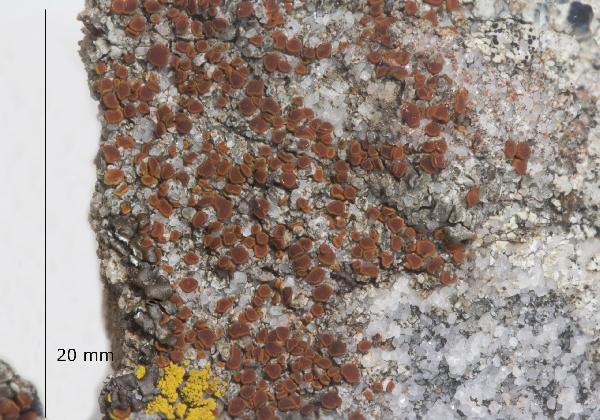
Marta González Garcia - Centro de Estudios Micologicos Asturianos
Spain, Valdorria (León), 11-VII-2024, sobre rocas ácidas junto a Candelariella coralliza y Pleopsidium chlorophanum a 1400 m de altitud, MGG-128.
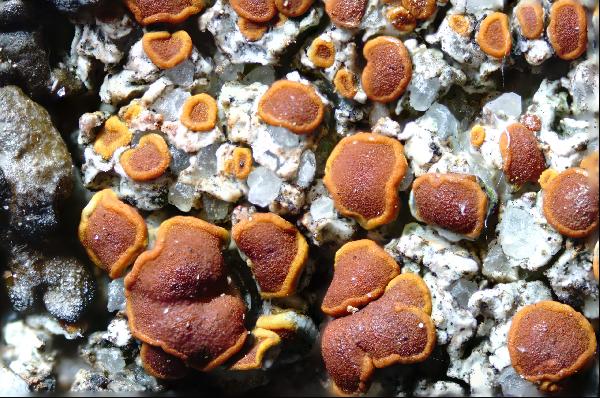
Marta González Garcia - Centro de Estudios Micologicos Asturianos
Spain, Valdorria (León), 11-VII-2024, sobre rocas ácidas junto a Candelariella coralliza y Pleopsidium chlorophanum a 1400 m de altitud, MGG-128.
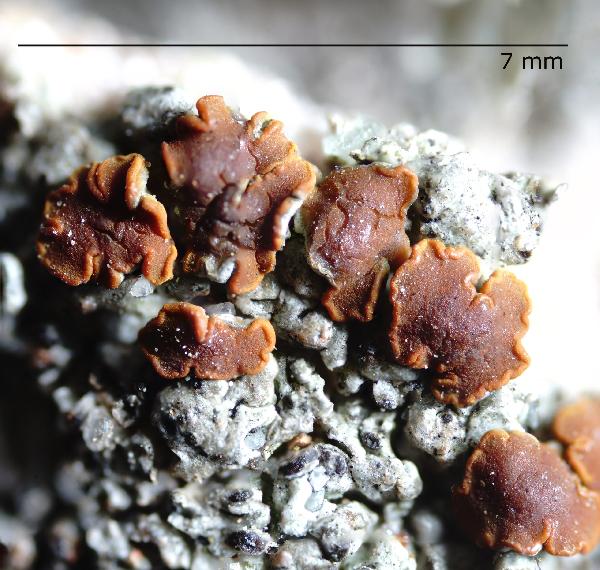
Marta González Garcia - Centro de Estudios Micologicos Asturianos
Spain, Valdorria (León), 11-VII-2024, sobre rocas ácidas junto a Candelariella coralliza y Pleopsidium chlorophanum a 1400 m de altitud, MGG-128.
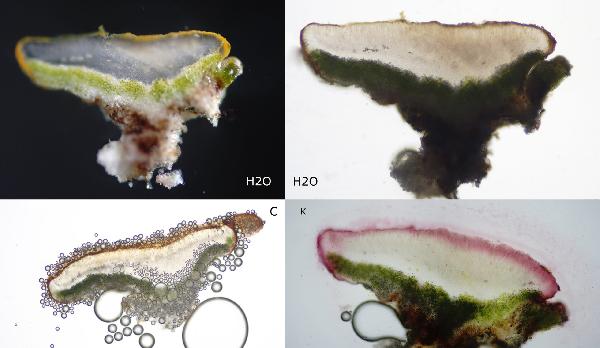
Marta González Garcia - Centro de Estudios Micologicos Asturianos
Spain, Valdorria (León), 11-VII-2024, sobre rocas ácidas junto a Candelariella coralliza y Pleopsidium chlorophanum a 1400 m de altitud, MGG-128.
Growth form: Crustose
Substrata: rocks
Photobiont: green algae other than Trentepohlia
Reproductive strategy: mainly sexual
Poorly known taxon in need of further study
Commonnes-rarity: (info)
Alpine belt: very rare
Subalpine belt: rare
Montane belt: rather rare
Dry submediterranean belt: rather common
Humid submediterranean belt: rather common
Padanian area: rare
pH of the substrata:
| 1 | 2 | 3 | 4 | 5 |
Solar irradiation:
| 1 | 2 | 3 | 4 | 5 |
Aridity:
| 1 | 2 | 3 | 4 | 5 |
Eutrophication:
| 1 | 2 | 3 | 4 | 5 |
Poleotolerance:
| 0 | 1 | 2 | 3 |
Altitudinal distribution:
| 1 | 2 | 3 | 4 | 5 | 6 |
Rarity
absent
extremely rare
very rare
rare
rather rare
rather common
common
very common
extremely common
Loading data...
Occurrence data
Predictive map
 Current prediction (1981-2010)
Current prediction (1981-2010) Future prediction (2071-2100) SSP 1-2.6
Future prediction (2071-2100) SSP 1-2.6 Future prediction (2071-2100) SSP 5-8.5
Future prediction (2071-2100) SSP 5-8.5Predictive maps according to Francesconi et al. 2025

Jacques Haine - Source: http://www.lichensmaritimes.org/index.php?task=fiche&lichen=277&lang=en
France, Ventoux

Jacques Haine - Source: http://www.lichensmaritimes.org/index.php?task=fiche&lichen=277&lang=en
France, Ventoux

Jacques Haine - Source: http://www.lichensmaritimes.org/index.php?task=fiche&lichen=277&lang=en
France, Ventoux

Jacques Haine - Source: http://www.lichensmaritimes.org/index.php?task=fiche&lichen=277&lang=en
France, Ventoux

Marta González Garcia - Centro de Estudios Micologicos Asturianos
Spain, Valdorria (León), 11-VII-2024, sobre rocas ácidas junto a Candelariella coralliza y Pleopsidium chlorophanum a 1400 m de altitud, MGG-128.

Marta González Garcia - Centro de Estudios Micologicos Asturianos
Spain, Valdorria (León), 11-VII-2024, sobre rocas ácidas junto a Candelariella coralliza y Pleopsidium chlorophanum a 1400 m de altitud, MGG-128.

Marta González Garcia - Centro de Estudios Micologicos Asturianos
Spain, Valdorria (León), 11-VII-2024, sobre rocas ácidas junto a Candelariella coralliza y Pleopsidium chlorophanum a 1400 m de altitud, MGG-128.

Marta González Garcia - Centro de Estudios Micologicos Asturianos
Spain, Valdorria (León), 11-VII-2024, sobre rocas ácidas junto a Candelariella coralliza y Pleopsidium chlorophanum a 1400 m de altitud, MGG-128.



